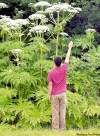Watching, waiting for hogweed
Advertisement
Read this article for free:
or
Already have an account? Log in here »
To continue reading, please subscribe:
Monthly Digital Subscription
$0 for the first 4 weeks*
- Enjoy unlimited reading on winnipegfreepress.com
- Read the E-Edition, our digital replica newspaper
- Access News Break, our award-winning app
- Play interactive puzzles
*No charge for 4 weeks then price increases to the regular rate of $19.00 plus GST every four weeks. Offer available to new and qualified returning subscribers only. Cancel any time.
Monthly Digital Subscription
$4.75/week*
- Enjoy unlimited reading on winnipegfreepress.com
- Read the E-Edition, our digital replica newspaper
- Access News Break, our award-winning app
- Play interactive puzzles
*Billed as $19 plus GST every four weeks. Cancel any time.
To continue reading, please subscribe:
Add Free Press access to your Brandon Sun subscription for only an additional
$1 for the first 4 weeks*
*Your next subscription payment will increase by $1.00 and you will be charged $16.99 plus GST for four weeks. After four weeks, your payment will increase to $23.99 plus GST every four weeks.
Read unlimited articles for free today:
or
Already have an account? Log in here »
Hey there, time traveller!
This article was published 28/07/2010 (5575 days ago), so information in it may no longer be current.
The hogweed invasion of Canada has not reached Manitoba yet, but the Invasive Species Council says that it is possible that it will, having already firmly established itself in British Columbia and Eastern Canada.
In fact, given the spread of other invasive species — that is plants and animals that are not native to a place but flourish there once they are introduced — hogweed’s arrival seems as inevitable as the annual crop of dandelions and purple loosestrife.
Like hogweed, they are not native to Canada but were imported by gardeners who admired them for their flowers. While hogweed itself is a far more unpleasant guest — it can reach a height of 15 metres, and all of it secretes a poisonous sap that causes "itching, oozing pustules and black and purple scars that can take years to fade," as it was described in the Free Press Tuesday. More seriously, even trace amounts can cause blindness if they find their way into one’s eyes. It also each year produces a spread of flowers, which is what gardeners originally found attractive and led to its being imported from Asia.
This is a common story, not confined to Canada. An Australian immigrant imported rabbits from England for sport hunting in the 19th century and led to what is today a pestilence of rabbits that is rapidly destroying parts of Australia. In the United States, an Asian vine, kudzu, caught gardeners’ eyes in the southern states and is now so deeply rooted in Georgia that it covers whole forests, sucking the life out of them, whole houses, smothering them, and threatens the city of Atlanta — it is aptly known as "the vine that ate the South."
None of this was malicious, but it was all done out of vanity — a better garden than your neighbour’s — or self-indulgence — the pleasure of killing rabbits — and now cannot, it seems, be undone. In Manitoba, we can only await hogweed’s arrival and hope to cope with it when it comes.


